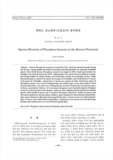

PARTNER
검증된 파트너 제휴사 자료
한반도 강도래목(곤충강)의 종다양성 (Species Diversity of Plecoptera (Insecta) in the Korean Peninsula)
11 페이지
최초등록일 2025.03.12
최종저작일
2009.03

-
서지정보
· 발행기관 : 한국환경생물학회
· 수록지 정보 : 환경생물 / 27권 / 1호 / 100 ~ 110페이지
· 저자명 : 함순아
초록
Korean Plecopteran research was started in 1921, and it has advanced greatly duringlast 20 years. Among families the family Nemouridae and Chloroperlidae are composed of plentifulspecies. Since North Korean Plecopteran research was begun in 1938, it made good progress byforeigners not North Korean in the 1970’s. Subsequently a few species has been added up recently,and among families the family Perlidae and Nemouridae contain most abundant species. TotallyKorean Plecoptera consists of 43 species in 25 genera in 10 families, and North Korean 37 speciesin 26 genera in 10 families. Among them 13 species are common in both. And Korean names ofPlecopteran species were mixed in Hangeul-type and Chinese-type, on the other hand in NorthKorean names there were some cases of Hangeul-type, but most of species have no Korean names.
In Korea, particularly Ministry of Environment designated and controlled domestic biologicalresources as Korean Species that Require Approval when shipping abroad and Korean endemicspecies, which include 9 species and 11 species in Plecoptera respectively. Finally two genera andfour species gained new Korean names as follows : genus Megaleuctra (Keun-Kkoma-Gang-Do-Rae-Sok), genus Haploperla (Han-Nok-Saek-Gang-Do-Rae-Sok), Nemoura brevicercia (Min-Gang-Do-Rae), Nemoura espera (Kkot-Min-Gang-Do-Rae), Amphinemura baei (Je-Ju-A-Ga-Mi-Min-Gang-Do-Rae) and Amphinemura rai (A-Ga-Mi-Min-Gang-Do-Rae).영어초록
Korean Plecopteran research was started in 1921, and it has advanced greatly during
last 20 years. Among families the family Nemouridae and Chloroperlidae are composed of plentiful
species. Since North Korean Plecopteran research was begun in 1938, it made good progress by
foreigners not North Korean in the 1970’s. Subsequently a few species has been added up recently,
and among families the family Perlidae and Nemouridae contain most abundant species. Totally
Korean Plecoptera consists of 43 species in 25 genera in 10 families, and North Korean 37 species
in 26 genera in 10 families. Among them 13 species are common in both. And Korean names of
Plecopteran species were mixed in Hangeul-type and Chinese-type, on the other hand in North
Korean names there were some cases of Hangeul-type, but most of species have no Korean names.
In Korea, particularly Ministry of Environment designated and controlled domestic biological
resources as Korean Species that Require Approval when shipping abroad and Korean endemic
species, which include 9 species and 11 species in Plecoptera respectively. Finally two genera and
four species gained new Korean names as follows : genus Megaleuctra (Keun-Kkoma-Gang-Do-Rae-
Sok), genus Haploperla (Han-Nok-Saek-Gang-Do-Rae-Sok), Nemoura brevicercia (Min-Gang-Do-
Rae), Nemoura espera (Kkot-Min-Gang-Do-Rae), Amphinemura baei (Je-Ju-A-Ga-Mi-Min-Gang-
Do-Rae) and Amphinemura rai (A-Ga-Mi-Min-Gang-Do-Rae).참고자료
· 없음태그
-
자주묻는질문의 답변을 확인해 주세요

꼭 알아주세요
-
자료의 정보 및 내용의 진실성에 대하여 해피캠퍼스는 보증하지 않으며, 해당 정보 및 게시물 저작권과 기타 법적 책임은 자료 등록자에게 있습니다.
자료 및 게시물 내용의 불법적 이용, 무단 전재∙배포는 금지되어 있습니다.
저작권침해, 명예훼손 등 분쟁 요소 발견 시 고객센터의 저작권침해 신고센터를 이용해 주시기 바랍니다. -
해피캠퍼스는 구매자와 판매자 모두가 만족하는 서비스가 되도록 노력하고 있으며, 아래의 4가지 자료환불 조건을 꼭 확인해주시기 바랍니다.
파일오류 중복자료 저작권 없음 설명과 실제 내용 불일치 파일의 다운로드가 제대로 되지 않거나 파일형식에 맞는 프로그램으로 정상 작동하지 않는 경우 다른 자료와 70% 이상 내용이 일치하는 경우 (중복임을 확인할 수 있는 근거 필요함) 인터넷의 다른 사이트, 연구기관, 학교, 서적 등의 자료를 도용한 경우 자료의 설명과 실제 자료의 내용이 일치하지 않는 경우
찾으시던 자료가 아닌가요?
지금 보는 자료와 연관되어 있어요!
문서 초안을 생성해주는 EasyAI


